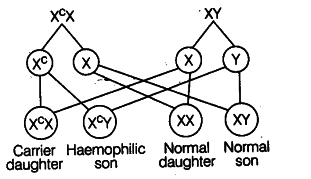(i) Why are thalassemia and haemophilia categorised as Mendelian disorders? Write the symptoms of these diseases. Explain their pattern of inheritance in humans.
(ii) Write the genotypes of the normal parents producing a haemophilic son.
(i) Thalassemia and haemophilia are categorised as Mendelian disorders because these disorders are due to alteration in a single gene. Also, they are transmitted to offsprings through Mendelian principles of inheritance.
Symptoms and pattern of inheritance are given below:
(a) Thalassemia It is an autosomal linked recessive blood disorder characterised by defect in a, (3 or 8 chain resulting in abnormal Hb molecule. Symptom Anaemia
Inheritance Two mutant alleles (one from each parent) must be inherited for an individual to be affected, i.e. homozygous. Heterozygous are carriers and may pass the mutant allele to children.
(b) Haemophilia It is a sex-linked recessive disorder whose gene is located on X-chromosome. Symptom Prolonged clotting time and internal bleeding, even in a minor injury.
Inheritance The gene is present on X-chromosome, so it is inherited by males as they have a single X-chromosome. Affected males are said to be hemizygous. Females have two X-chromosomes, thus possibility of them being affected is rare as the mother of such female has to be atleast carrier and father should be haemophilic.
(ii) Genotypes of the normal parents producing a haemophilic son are Xc X (carrier mother) and XY (father).
